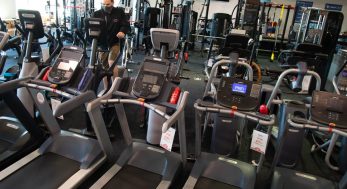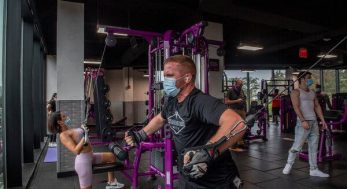When Glen Pendlay passed away on September 5th, 2019, the world lost one of the best and most successful weightlifting and powerlifting coaches ever. Pendlay had been a coach since 1996, and in addition to helping hundreds of athletes reach their competitive peak, he also invented a type of barbell row that became known as the Pendlay row.
According to coach Pendlay, his row helps exercisers perform bent-over rows properly, i.e., with a safe and strong torso position, and without jerking or heaving the bar up with the legs. According to Pendlay, most exercisers do not perform bent-over rows properly, and therefore do not get good results from this traditional barbell back exercise.
But what are Pendlay rows, and why should you do them?
Table of Contents show
Pendlay row benefits
Pendlay rows are also called dead stop barbell rows. Each repetition starts with the weight resting on the floor. This ensures that you do your rows with your body at the best angle for upper back development – with your spine all but parallel to the floor.

In addition, by starting each rep from a dead stop, you cannot use momentum to lift the weight. Instead, you have to rely on muscle power which means that Pendlay rows are an excellent back builder.
In contrast, regular barbell rows are easy to do improperly. Sloppy technique may allow you to lift more weight, but much of that work is done with your legs and using momentum. This means the target muscles receive much less stimulation.
Pendlay rows work the following muscles:
- Latissimus dorsi – also known as the lats, these muscles connect your upper arms to your torso. They are the wing-shaped muscles on the side of your upper back.
- Middle trapezius – the central part of the diamond-shaped muscle covering your upper back. The middle traps pull your shoulder blades together.
- Rhomboids – small muscles located between your shoulder blades. They work with the middle traps to pull your shoulder blades together.
- Posterior deltoids – the rearmost of the three deltoid or shoulder muscles.
- Biceps brachii – the main muscle on the front of your upper arm, and usually just called the biceps.
- Erector Spinae – the muscles that make up your lower back.
In addition, Pendlay rows also involve your legs, glutes, and core. These muscles work isometrically or statically to stabilize your body and hold you in position.
The Pendlay row can be used to build muscle or strength. It all depends on how much weight you use, and the number of reps you perform.
- For strength, do 2-5 reps per set using very heavyweights.
- For muscle growth, do 6-12 reps per set using moderate to heavyweights.
How to do Pendlay rows properly
To get the most from this or any other exercise, you must do it properly. Like bent over rows, Pendlay rows can put a lot of stress on your lower back. If you don’t do them right, you could end up with a severe injury. Learn and practice this exercise with light weights and only increase the load when you have mastered it.
- Start with your barbell on the floor. Stand with your feet about hip to shoulder-width apart, toes under the bar.
- With your knees slightly bent, hinge forward from the hips and bend over until your upper body is parallel to the floor. Make sure your lower back is slightly arched and not rounded. Grab the barbell with an overhand, slightly wider than shoulder-width grip. Tuck your chin in and lengthen your neck; do not lift your head and look forward.
- Brace your core, squeeze your shoulder blades together, and pull the bar up into your abdomen. The bar should touch your stomach. Lead with your elbows, keeping your upper arms tucked in close to your sides. Your upper body should remain stationary throughout. Do not use your legs or lower back to lift the weight. If you can’t keep your upper body still, you are probably using too much weight.
- Under control, lower the barbell back down the floor and allow it to touch down. Reset your core and repeat.
Pendlay Row modifications and variations
The standard version of Pendlay rows is an excellent exercise for building muscle and strength. However, studies say that exercise variety is important for making optimal progress (1).
Here are a few Pendlay row modifications and variations you can use to spice up your workouts.
Dumbbell Pendlay rows
Dumbbells allow you to work your muscles through a larger range of motion, which makes the exercise harder. Also, using dumbbells will allow you to identify and fix left to right strength imbalances. If ignored, these imbalances can affect not only how you look, but could also lead to injury.
- Place two dumbbells on the floor, roughly shoulder-width apart. The dumbbells handles should be parallel so you can use a neutral or palms-in grip. Stand between the weights with your knees slightly bent.
- Lean forward from your hips and reach down to grab the dumbbells. Keep your back flat and your torso level with the floor. Brace your abs.
- Bend both arms and pull the dumbbells up and into your ribs. Pull your shoulders back and keep your upper arms close to your sides.
- Lower the weights back down to the floor, reset and repeat.
Alternating arm Pendlay rows
This variation allows you to work your upper body hard while taking some stress off your lower back. Your non-working arm provides a small amount of support and lifting just one dumbbell at a time means your back won’t have to support as much weight.
- Place two dumbbells on the floor, roughly shoulder-width apart. Stand between them with your knees slightly bent.
- Lean forward from your hips and reach down to grab the dumbbells. Keep your back flat and your torso level with the floor. Brace your abs.
- Bend one arm and pull the dumbbell up and into your side. Keep your upper arm close to your body.
- Lower the weight back to the floor and then repeat on the opposite side. Continue alternating arms for the duration of your set.
Single-arm Pendlay rows
Only got one dumbbell. No problem! You can also do Pendlay rows using one arm at a time. In addition to working your upper back, lower back, and biceps, this variation also works your waist or oblique muscles.
As well as having to hold your torso parallel to the floor, you’ll also have to work hard to prevent your shoulders and hips from rotating. Perform this exercise the same way you would do regular dumbbell Pendlay rows but using one arm at a time. Do the same number of reps on each side.
Modified Pendlay rows
A lot of lifters find that they round their backs when doing Pendlay rows. A rounded back is a weak lower back, putting lots of stress on the ligaments and discs of the spine. Tight hamstrings can make it hard to hinge forward with a straight back.
Get around this problem by raising the height of the weights so that you do not have to lean so far forward. For example, place it on stacks of weight plates, pins set low in a power rack, or on two sturdy steps. Raising the bar by just 6-12 inches will take a lot of stress off your lower back.
You can use this modification for barbell, dumbbell, and single-arm Pendlay rows. However, you should also work on your hamstring flexibility with plenty of stretching so that you can progress toward doing this exercise as coach Pendlay intended – from the floor.
Conclusion
Bodybuilders often say that, if you want your back to grow, you have got to row! Lat pulldowns and pull-ups great back exercises, but for maximal size and strength, you should also include rowing exercises in your back-training program.
There are lots of rowing exercises to choose from, such as cable rows, body rows, and chest supported machine rows, but Pendlay rows are another great option. Add them to your workouts and your back will thank you for it!
References:
Journal of Strength and Conditioning Research: Changes in Exercises Are More Effective Than in Loading Schemes to Improve Muscle Strength

